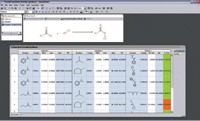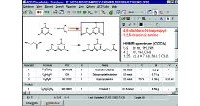Advertisement
Grab your lab coat. Let's get started
Welcome!
Welcome!
Create an account below to get 6 C&EN articles per month, receive newsletters and more - all free.
It seems this is your first time logging in online. Please enter the following information to continue.
As an ACS member you automatically get access to this site. All we need is few more details to create your reading experience.
Not you? Sign in with a different account.
Not you? Sign in with a different account.
ERROR 1
ERROR 1
ERROR 2
ERROR 2
ERROR 2
ERROR 2
ERROR 2
Password and Confirm password must match.
If you have an ACS member number, please enter it here so we can link this account to your membership. (optional)
ERROR 2
ACS values your privacy. By submitting your information, you are gaining access to C&EN and subscribing to our weekly newsletter. We use the information you provide to make your reading experience better, and we will never sell your data to third party members.
Synthesis
Digital Briefs
New Software and Websites for the Chemical Enterprise
by Noah U. Shussett
July 14, 2008
| A version of this story appeared in
Volume 86, Issue 28
Software
SYBYL is a computational informatics program for molecular modelers involved in discovery projects. The software specializes in ligand-based design (pharmacophore perception and molecular alignment), receptor-based design (docking and de novo design), structural biology (macromolecular modeling and bioinformatics), library design (library creation and molecular diversity), and cheminformatics (data mining and structure representation). The software aims to provide the user with a higher level of control in producing and optimizing lead molecular candidates, to save time by simplifying workflows, and to accelerate the pace of discovery. SYBYL achieves these goals through its architecture, which includes a standard base module for visualizing and comparing attributes of molecular models and structures. Optional base modules allow enhanced visualization, conformational searching, and interoperability among other SYBYL application groups. Recent updates to SYBYL give it a new look and feel. These include new automated tools that can search for and identify the substituents and R groups predicted to optimize the activity of their compounds and an advanced protein-modeling system. SYBYL is installed locally and supports Linux (RHEL 4 and above) and SGI/IRIX, with Mac compatibility in the works. Tripos, www.tripos.com
Origin 8 is a data analysis and graphing workspace for scientists and engineers. The workspace includes multisheet workbooks (with rich-text formatting, the ability to embed images in worksheet cells, mixed text and numeric capabilities, and metadata transfer), publication-quality graphics (2-D, 3-D, statistical, and contour graphs compatible with PowerPoint, CorelDraw, and Microsoft Word or any OriginLab application), and standardized analysis tools (including hypothesis testing, FFT, linear regression, and descriptive statistics) for importing data, creating graphs, and then analyzing and publishing results. Built-in tools include nonlinear curve fitting, regression, signal processing, image processing, and peak analysis. The program can automatically update any analysis operation whenever source data or analysis parameters are changed. The program includes a high-level, full-featured programming language providing industry-standard command capabilities. The software runs on Microsoft Windows (NT 4.0 or later, 2000, XP, and Vista) and Intel-based Macs. OriginLab, www.originlab.com
PCMODEL version 9.2 is a molecular modeling package designed and built by research chemists to be a versatile tool for research chemists. A menu-driven structure input mode allows the user to draw structures as they would on paper; substitute, move, and delete atoms; and set atoms and distances in space. Substructure functions afford space for up to 32 named substructures to be created, moved, docked, and rotated on screen. Adding and deleting hydrogens and lone pairs is a click of a button away. The software has 60 atom types and generalized parameters for transition metals, as well as built-in MMX minimizations and support for MM3, MMFF94, Amber, and Oplsaa force fields. New features include the OpenGL graphics engine; conformational searching; interfaces for the computational tools Gaussian, Gamess, Mopac, ADF, and PQS; and support for Orbital and Vibrational Mode display. User-defined constants and bond angles, parameter files, bond lengths, and torsion constants ensure that the software can handle what the user needs. Microsoft Windows, Mac OS X, and Linux support the software. Serena Software, www.serenasoft.com
ChemoSoft is a software package for chemists and drug or molecular designers who work with computer-aided design tools. The software uses a wide variety of integrated applications, from 2-D chemoinformatics tools to 3-D molecular modeling programs. The 2-D tools are based on a chemical database management system (with enough storage space for 10 million structures) and provides a substructure search engine with options including compound selection for screening or enrichment, maximum dissimilarity selection, sorting by diversity relative to a data set, hierarchical clustering by an advanced algorithm, and diversity of heterocyclic scaffolds. Lead optimization can be carried out by implementing quantitative structure-activity relationship (QSAR) methodology. This includes calculation capabilities of 140-plus molecular descriptors, which include atom-type electrotopological state (E-state) indexes; Wiener, Zagreb, Randic, Narumi, Petitjean, Hosoya, Harary, and Balaban indexes; topological radius and diameter; Kier-Hall connectivity indexes; Schultz’s MTI and Kier kappa shape indexes; Kier flexibility, symmetry, and steric indexes; van der Waals volume; and cycle, bond, and atom counts. The 3-D tools for investigations of small molecules consist of a 2-D/3-D molecular converter/generator of multiple stereoisomers, an editor of 3-D pharmacophore queries, a pharmacophore search engine, and a 3-D molecule viewer. The software runs on PCs equipped with Microsoft Windows 2000, XP, or Vista. ChemDiv, www.chemdiv.com
Noah U. Shussett writes Digital Briefs. Information about new or revised electronic products can be sent to d-briefs@acs.org.







Join the conversation
Contact the reporter
Submit a Letter to the Editor for publication
Engage with us on Twitter